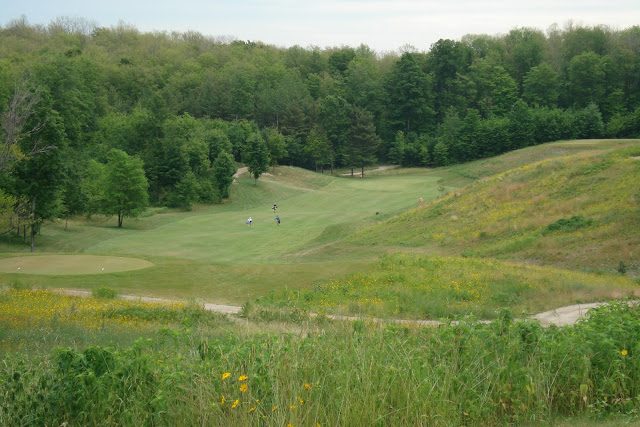Golf course architects have more often than not, responded to the advances in equipment technology by building longer golf courses. I detailed the negative consequences this knee-jerk reaction has had on the game of golf a few posts back. In the last 20 years, a growing group of golf course architects (though still a minority) have taken a different path and built golf courses which are more pronounced for their width than length. While their brawnier neighbours exasperate the cost, time and difficulty problems that hinder the growth of golf, wider playing corridors offer a bright light of hope that golf can confront and overcome the above-mentioned issues and provide a sustainable path forward for the sport.
Narrow fairways that are hemmed in by long rough and trees offer little in the way of strategic options. Golfers are just happy to hit the fairway as the reward for playing safely to the edge of the fairway to improve the angle of approach are limited and not worth the risk. Wide fairways allow for a greater array of approach angles, and thus, many more strategic options with greater rewards for success and higher degrees of difficulty for those approaching from the wrong side of the fairway. Rewards and punishments are meted out incrementally as opposed to in lost balls, unplayable lies and chip-outs.
 |
At under 30 yards in width, the difference between middle of the fairway and the ideal right hand side on the approach into No. 18 at Richmond Country Club is limited and not necessarily worth the risk of sand and trees.
Photo: Richmond CC in Richmond, British Columbia
|
Incorporating width into a design must have strategic merit, as width for the sake of width is as dull and wasteful as length for the sake of length. Wider fairways, like longer golf courses require more irrigation heads and pipe, therefore the additional width best be a viable alternative for some players or it is not money well spent.
 |
Too wide? At 125 yards from right edge of fairway to left, the 1st at Kingsley Club is inviting from the tee, but how many golfers opt the left hand side with fairway running away and trees blocking second shots?
Photo: Kingsley Club in Kingsley, Michigan |
A wide fairway is inviting to all classes of golfer, however, in order to score, the actual target in the wide sea of short-grass is often much narrower. Approach shots into the green should be progressively more challenging the safer the route chosen from the tee.
 |
A 75 yard wide fairway awaits at the 15th tee at Barnbougle Dunes however, the further left one plays of the central fairway bunker (furthest right in the above picture), the more blind becomes the approach.
Photo: Barnbougle Dunes in Bridport, Tasmania, Australia |
 |
An aerial view illustrates the wide playing corridor of the 15th at Barnbougle Dunes, but those seeking the best angle of approach need to challenge the central bunker, bringing it and long marram grass right into play.
Photo: Barnbougle Dunes courtesy of Google Earth |
Golf courses that provide wider fairways are successfully addressing the three major problems that currently stifle growth of the game, time, difficulty and cost. Wider fairways set the stage for faster golf, as players are much less frequently suffering the irritation of searching for lost balls in long rough or trees due to the greater margin of error afforded by the design. Players in the mid to high handicap range are also likely taking fewer strokes as more shots are played from the fairway, further reducing the time required to complete a round. Combine wider fairways with a shorter overall course yardage (which most proponents of wider golf courses practice) and we can realize even greater time savings.
Ensuring that the width provided enhances the strategic element of the hole design, wider golf courses can present a challenging prospect for elite players and still make for a less daunting and more enjoyable experience for mid to high handicap players. Golf is difficult, and wider golf courses are more user-friendly by offering an alternative route around the strategically placed hazards for those unwilling or unable to challenge them head-on at the cost of a stroke or two per hole. Wide golf courses can lull the best players into a false sense of security, as anything in the fairway is usually good on most modern courses. However, greater width means many more angles of approach, and in some instances, only a narrow strip of fairway providing an ideal line and stance. Wider is easier for those who find golf too difficult by limiting big numbers or x's, and if designed appropriately, still challenges the most proficient players who can be bogied to death by constantly playing from out of position but in the fairway. Additionally, wider golf courses are multi-dimensional, allowing players to choose the path to the hole that most suits their game, and therefore, many different means of achieving the same score. Wider is simply more interesting.
The final obstacle to the health of the game is cost. The green fee paid at public golf courses is tied to the initial expense of building the golf course. While selecting an ideal site in terms of topography, soils and proximity to demand are the most important ingredients in providing affordable golf, all things being equal, wide fairways offset the savings generated by shorter holes, and increased fairway acreage is more costly in terms of annual maintenance. However, the ability of wider golf courses to provide faster rounds that do not beat up the average player and provide a more enjoyable golf experience will be subject to increased rates of returning players, providing a steadier stream of revenue over the long term. Further, faster play will enable more players to utilize a golf course each day, boosting revenues of daily fee facilities even higher.




















































